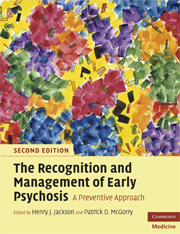42 results
Psychometric properties of a brief, self-report measure of social inclusion: the F-SIM16
-
- Journal:
- Epidemiology and Psychiatric Sciences / Volume 31 / 2022
- Published online by Cambridge University Press:
- 21 January 2022, e8
-
- Article
-
- You have access
- Open access
- HTML
- Export citation
Individual placement and support for vocational recovery in first-episode psychosis: randomised controlled trial
-
- Journal:
- The British Journal of Psychiatry / Volume 214 / Issue 2 / February 2019
- Published online by Cambridge University Press:
- 25 September 2018, pp. 76-82
- Print publication:
- February 2019
-
- Article
-
- You have access
- HTML
- Export citation
Contributors
-
-
- Book:
- The Cambridge Dictionary of Philosophy
- Published online:
- 05 August 2015
- Print publication:
- 27 April 2015, pp ix-xxx
-
- Chapter
- Export citation
The Practice of Behavior Therapy: (Third edition)Joseph Wolpe New York: Pergamon Press, 1982, pp. 389
-
- Journal:
- Behaviour Change / Volume 2 / Issue 2 / June 1985
- Published online by Cambridge University Press:
- 06 October 2014, pp. 156-158
-
- Article
- Export citation
On the Relationship of Psychiatric Diagnosis to Behavioural Assessment
-
- Journal:
- Behaviour Change / Volume 1 / Issue 1 / March 1984
- Published online by Cambridge University Press:
- 06 October 2014, pp. 10-16
-
- Article
- Export citation
Early Psychosis Prevention and Intervention: Evolution of a Comprehensive Community-Based Specialised Service
-
- Journal:
- Behaviour Change / Volume 11 / Issue 4 / December 1994
- Published online by Cambridge University Press:
- 06 October 2014, pp. 223-233
-
- Article
- Export citation
Accessibility of Diagnostic Categories and Causal Attributions for an Interviewee's Behaviour
-
- Journal:
- Behaviour Change / Volume 5 / Issue 4 / December 1988
- Published online by Cambridge University Press:
- 06 October 2014, pp. 175-180
-
- Article
- Export citation
Introduction to Mini-Series on Schizophrenia
-
- Journal:
- Behaviour Change / Volume 2 / Issue 2 / June 1985
- Published online by Cambridge University Press:
- 06 October 2014, pp. 78-79
-
- Article
- Export citation
Therapy Contamination as a Measure of Therapist Treatment Adherence in a Trial of Cognitive Behaviour Therapy versus Befriending for Psychosis
-
- Journal:
- Behavioural and Cognitive Psychotherapy / Volume 43 / Issue 3 / May 2015
- Published online by Cambridge University Press:
- 29 October 2013, pp. 314-327
- Print publication:
- May 2015
-
- Article
- Export citation
Road to full recovery: longitudinal relationship between symptomatic remission and psychosocial recovery in first-episode psychosis over 7.5 years
-
- Journal:
- Psychological Medicine / Volume 42 / Issue 3 / March 2012
- Published online by Cambridge University Press:
- 19 August 2011, pp. 595-606
-
- Article
- Export citation
Contributors
-
-
- Book:
- The Causes of Epilepsy
- Published online:
- 05 March 2012
- Print publication:
- 14 April 2011, pp ix-xvi
-
- Chapter
- Export citation
12 - Psychiatric diagnoses: purposes, limitations and an alternative approach
- from Section 2 - The importance of methods
-
-
- Book:
- The Neuropsychology of Mental Illness
- Published online:
- 10 May 2010
- Print publication:
- 01 October 2009, pp 178-193
-
- Chapter
- Export citation
Contributors
-
-
- Book:
- The Neuropsychology of Mental Illness
- Published online:
- 10 May 2010
- Print publication:
- 01 October 2009, pp xv-xx
-
- Chapter
- Export citation

The Recognition and Management of Early Psychosis
- A Preventive Approach
-
- Published online:
- 10 August 2009
- Print publication:
- 19 February 2009
The Recognition and Management of Early Psychosis - Half title page
-
- Book:
- The Recognition and Management of Early Psychosis
- Published online:
- 10 August 2009
- Print publication:
- 19 February 2009, pp i-ii
-
- Chapter
- Export citation
Section 1 - Introduction
-
- Book:
- The Recognition and Management of Early Psychosis
- Published online:
- 10 August 2009
- Print publication:
- 19 February 2009, pp 1-28
-
- Chapter
- Export citation
Contributors
-
-
- Book:
- The Recognition and Management of Early Psychosis
- Published online:
- 10 August 2009
- Print publication:
- 19 February 2009, pp xi-xvi
-
- Chapter
- Export citation
Copyright page
-
- Book:
- The Recognition and Management of Early Psychosis
- Published online:
- 10 August 2009
- Print publication:
- 19 February 2009, pp iv-iv
-
- Chapter
- Export citation
1 - Rationale for and overview of the second edition ofThe Recognition and Management of Early Psychosis
- from Section 1 - Introduction
-
-
- Book:
- The Recognition and Management of Early Psychosis
- Published online:
- 10 August 2009
- Print publication:
- 19 February 2009, pp 3-16
-
- Chapter
- Export citation
Section 7 - The critical period: specific interventions
-
- Book:
- The Recognition and Management of Early Psychosis
- Published online:
- 10 August 2009
- Print publication:
- 19 February 2009, pp 303-382
-
- Chapter
- Export citation



